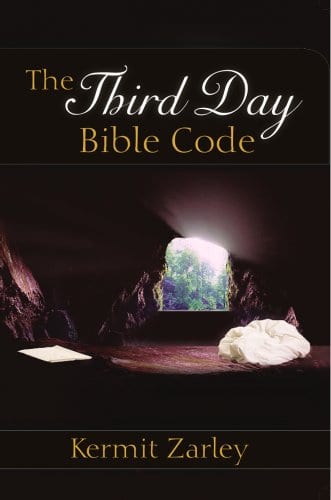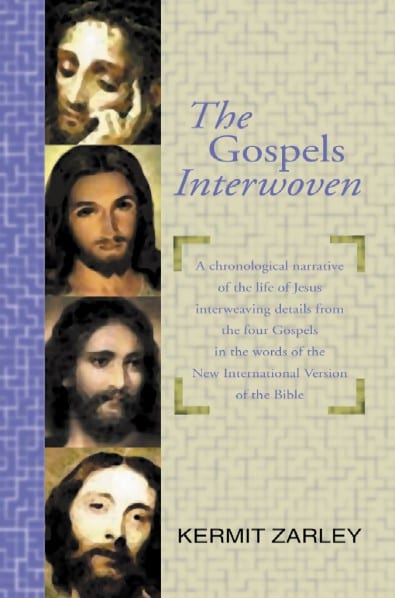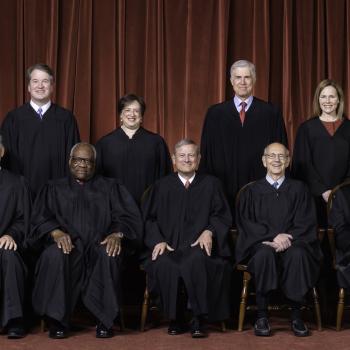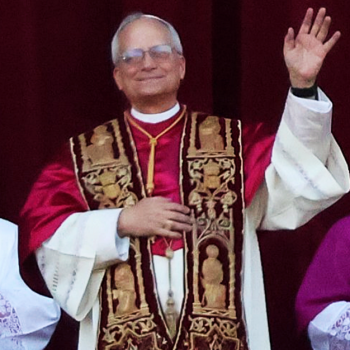 The image on the front cover of my book, The Third Day Bible Code, was inspired by Mel Gibson’s movie, “The Passion of the Christ.” I made this image myself. I took an image of a cave from inside it. I then changed it quite a bit. I bought a 4’x8′ sheet of plywood and spray-painted it. I then covered part of it with sand. I took some white sheets and laid them on top of this plywood sheet. I took a photo of it and merged it with the cave image. This result is supposed to look like a shelf inside an ancient cave-tomb in which a deceased body is placed therein on a ledge.
The image on the front cover of my book, The Third Day Bible Code, was inspired by Mel Gibson’s movie, “The Passion of the Christ.” I made this image myself. I took an image of a cave from inside it. I then changed it quite a bit. I bought a 4’x8′ sheet of plywood and spray-painted it. I then covered part of it with sand. I took some white sheets and laid them on top of this plywood sheet. I took a photo of it and merged it with the cave image. This result is supposed to look like a shelf inside an ancient cave-tomb in which a deceased body is placed therein on a ledge.
During antiquity, Jews and others with financial means often did this for their deceased loved ones. The flesh of the dead person would then decompose for about a year until there was nothing but bones. These bones would then be transferred to a sarcophagus where they would remain indefinitely.
Mel Gibson’s 2004 movie, “The Passion of the Christ,” was a box office sensation. He couldn’t get a Hollywood studio to take it on. So, he financed and produced it himself for $30 million, and it grossed over $600 million worldwide. He was going to produce it with all the dialogue in the Aramaic language. Had he done that, it surely would have gone bust. The story is that at the last moment, before they started shooting the film, Gibson was convinced by others to do it mostly in English.
I saw the film the day it was released. The last scene is a prolonged darkness and silence. Then you hear a screeching noise. Next, there is sunlight coming through an opening into this darkness. Then moviegoers realize the camera is shooting from inside a cave. It is supposed to be similar to where Jesus’ deceased body had been laid. The screeching noise is the tombstone being rolled away from the tomb entrance. The sunlight is shining through the tomb entrance. Jim Caviezel, the actor who plays Jesus, walks out of the tomb. The film then ends.
I walked out of that movie theater, alone, and had what I regard as one of those Eureka moments that I get occasionally in my life. I thought to myself that that last scene in the film was message. It was that if this film is successful, there will be a sequel to it, and this sequel will be about Jesus’ resurrection. I don’t know if that’s what Mel Gibson had in mind. But that’s the way it looked to me.
And I also thought a film on Jesus’ resurrection could be more successful than one about his crucifixion. Why? The Romans crucified tens of thousands of people per year for many decades. Most of them probably were slaves. So, Jesus’ crucifixion, as horrible as it was, happened all the time to people in the Roman Empire. But a dead person coming back to life, rising from the tomb, and going around proving it? Do I even need to say it? That doesn’t happen all the time! In fact (and I’ve written this in one of my books), “Jesus’ resurrection from the dead is the foundation of Christianity. Without it, there never would have been any Christianity!”
Even though this film project was by far the most successful Mel Gibson has ever undertaken–though Braveheart is pretty good–Gibson got a lot a flack about this film. Jews were especially incensed. They complained that it showed the Sanhedrin officials, who condemned Jesus, in a bad light. I concur, and that was what Gibson wanted. The film was gory in presenting Jesus’ crucifixion, which gave the film its R rating. Yet experts defend Gibson on this.
Not surprising to me was that many church leaders told Gibson that they wished he would have put something at the end of the film about Jesus’ resurrection. I thought “no way; it’s perfect the way it is since it provides for the resurrection as a sequel film.”
Well, fifteen years later, it looks as though that is going to become a reality. Almost three years ago, Gibson and Randall Wallace, who wrote Braveheart, announced they were working together on a sequel to “The Passion,” it being on Jesus’ resurrection. Gibson had said then that the project was “big” and that they thought the film would be released in late 2019 or early 2020.
When I walked out of that film, I said to myself out loud, “I’m gonna write a screenplay about Jesus’ resurrection.” That was crazy! I knew nothing about writing film scripts. But I added, “I’ve already done that work.”
What I meant was that in writing a screenplay on Jesus’ resurrection, the bulk of moviegoers who would see such a film would be Christians. One third of the world’s population, about 2.3 billion people, profess to be “Christian.” And I think such a film should be entirely about Jesus’ post-resurrection appearances as portrayed in the four New Testament gospels. (No human being literally saw Jesus arise from the dead and walk out of the tomb.) There are either ten or eleven such appearances in the gospels.
Christians base their faith mostly on the Bible. And Evangelicalism do this more than any other large segment of Christianity. Gibson admits that Evangelicals, but also Catholics, had a lot to do with the success of “The Passion.” Most Christians, but especially Evangelicals since many of them are Bible students, want Jesus’ films to be according to the Bible as much as possible.
 Well, my first book, The Gospels Interwoven (1987, 415 pp.) which was endorsed by evangelist Billy Graham, is a single-narrative harmony (also called “a composite”) of the four New Testament (NT) gospels in the New International Version of the Bible (NIV). So, it has a running narrative of all ten of Jesus’ post-resurrection appearances. Of all biblical material, this is the most difficult to write about. It is difficult to get a correct chronology of events. It is difficult to harmonize all of the gospel details, especially when two or more gospels relate the same post-resurrection appearance of Jesus.
Well, my first book, The Gospels Interwoven (1987, 415 pp.) which was endorsed by evangelist Billy Graham, is a single-narrative harmony (also called “a composite”) of the four New Testament (NT) gospels in the New International Version of the Bible (NIV). So, it has a running narrative of all ten of Jesus’ post-resurrection appearances. Of all biblical material, this is the most difficult to write about. It is difficult to get a correct chronology of events. It is difficult to harmonize all of the gospel details, especially when two or more gospels relate the same post-resurrection appearance of Jesus.
Anyone who is going to write a screenplay about Jesus’ post-resurrection appearances should do some serious, in-depth research on this subject. That includes reading a lot of material by expert scholars and searching through many Bible commentaries. I did a lot of that in compiling my single-narrative harmony. But this book has two parts. The first part is the harmony, and the second part consists of 130 questions, keyed to the harmony text, which address the harmonizing difficulties encountered when reading the NT gospels. In answering these questions, I appeal to the writings of leading NT scholars.
So, in 2004-5, I took a course on screenwriting. I then wrote a screenplay on Jesus’ post-resurrection appearances in accordance with the NT gospels. I used what I had in my The Gospels Interwoven. Then I also wrote a 100-page paper, which I call “an apparatus,” that represents further research. Some of it verifies scenes in the script.
I then tried to shop this script around in Hollywood without an agent, which is about impossible. I did meet in person Ben Fitzgerald, Gibson’s scriptwriter for “The Passion of the Christ.” We communicated several times thereafter. He read my script and liked it. He was amazed that I could do that good a job for a first script. He said it only needed “a polish” from a professional. He then was recommending it to the industry.
Randall Wallace’s son now works with his dad. Two years ago, I talked to him on the phone about my script. He responded as people in the film industry usually do, saying they don’t accept anything from anyone unless they commission it, which is seldom.
Back in 2005, Mel Gibson was the biggest star in Hollywood. And his agent, Ed Limato, was about as important as Gibson was. I wrote a one-page query letter to him. Now deceased, he had been Mel Gibson’s agent for many years. Ed phoned me immediately upon receiving this letter. I was elated, since it is so tough to break through in this business. But we were not on the same page. He also represented Jim Caviezel, who played the role of Jesus in “The Passion.” Ed thought I wanted to make a film and hire Jim. I don’t know how he got that idea from my clear one-page on which I worked many hours. I only wanted somebody to read my script and get interested in it!
This script has been sitting on my bookshelf ever since. Of course, I’m still very interested in this film genre. Here are my notes about what has been reported about this film project on which Mel Gibson and Randall Wallace are working.
2/7/2019 Gibson and Wallace have been working on this for years. They announced it in 2016. They said it will be a sequel to “The Passion of the Christ.” They are titling it “The Passion of the Christ: Resurrection.” That seems too long. Probably won’t matter.
The Hollywood Reporter reported in 2016 that Randall Wallace said, “The evangelical community considers ‘The Passion’ the biggest movie ever out of Hollywood, and they kept telling us that they think a sequel will be even bigger.” Wallace is writing the script. He called Jesus’ resurrection “a huge and sacred subject.” Wallace has a religion degree from Duke University. He said, “I always wanted to tell this story. The Passion is the beginning and there’s a lot more story to tell.”
Also, in 2016, Mel Gibson explained that this film will not be “a chronological telling” about Jesus’ resurrection. He said part of the film will occur “in another realm.” That is, it will explore Jesus’ experiences in the time between his death and resurrection. Gibson explained, “You’re going all over the place. What happened in the three days? . . . I’m not sure, but it’s worth thinking about. Get your imagination going.” He added, “We’re trying to craft this in a way that’s cinematically compelling and enlightening so that it shines new light, if possible, without creating some weird thing.” Gibson said the film would not be released until late 2019 or early 2020 because it is “a big subject.”
Wow! I believe Gibson will be out-to-lunch if he does that! Interesting perhaps, but unbiblical. This idea is based on the soul being immortal. That is what most Christians believe, but it is not biblical. The Old Testament teaches that when all people die their unconscious souls go down to Sheol, which is located deep inside the earth, to await resurrection. The word sheol appears 67x in the Hebrew Bible (Old Testament). The Greeks believed in the same concept, calling it hades. The word hades appears 12x in the NT. Most of the ancient world believed this and referred to it as “the underworld.”
Since Gibson included stuff about Satan in “The Passion,” his imagination may run wild about souls in sheol. Christians generally believe (the risen?) Jesus took the souls of deceased believers from sheol to heaven at some time between Jesus’ death and heavenly ascension, which occurred forty days after his resurrection (Acts 1.3, 9-11).
That may make my script more valuable. It therefore appears that this Gibson-Wallace film will have material about Jesus’ soul being conscious in Sheol-Hades and it will have a bunch of non-biblical material in it. A film about Jesus’ resurrection that has a lot of imagination in it, which therefore is non-biblical, will not set well with the evangelical community. Yet, Evangelicals will certainly go see it. The imaginative part will arouse controversy.
And Gibson saying “three days” is probably off-base since he likely means it as we English speakers do rather than as scripture does. According to church tradition, which the Bible verifies, Jesus died on Friday afternoon and was resurrected early Sunday morning, the third day. See “Did Jesus Rise on the ‘Third Day’ or After ‘Three Days.'”
Jim Caviezel gave an interview in 1/2018 to USA TODAY about this proposed film. He revealed that he will play Jesus in it. He said it will be “the biggest film in history” and that it will “shock the audience.” Two months later Caviezel explained, “Our industry, often times when they do a film that is biblical, they change it in many ways . . . when you start doing that and taking liberties like that . . . it loses its value.” AMEN brother!












